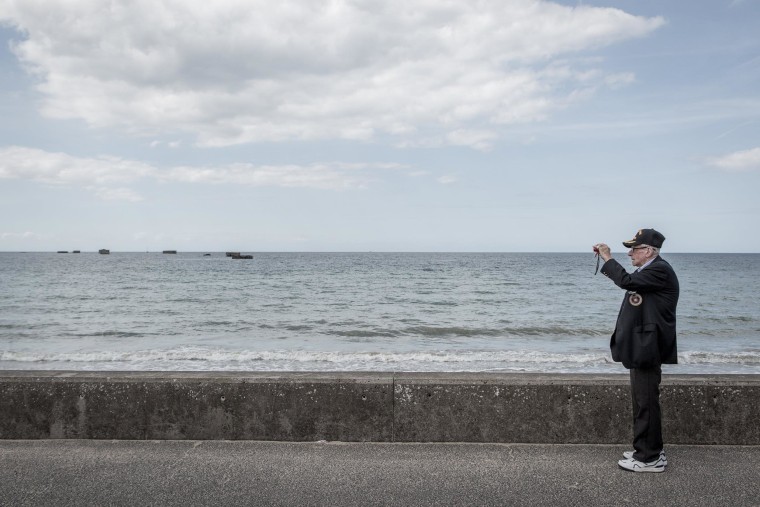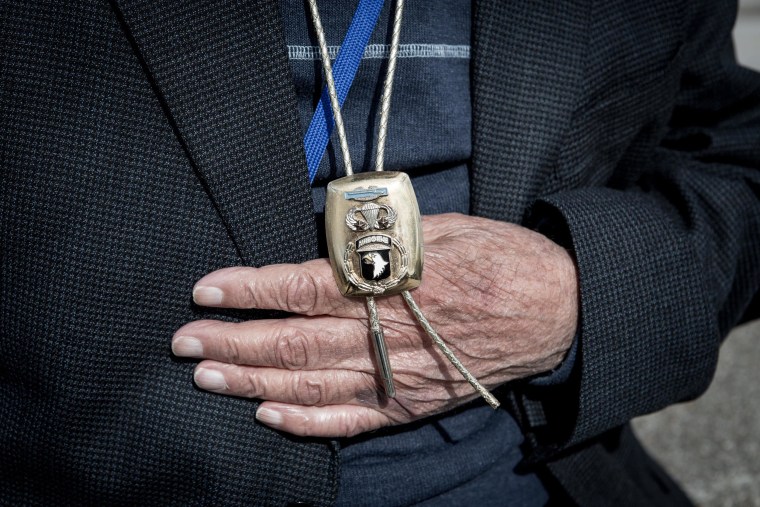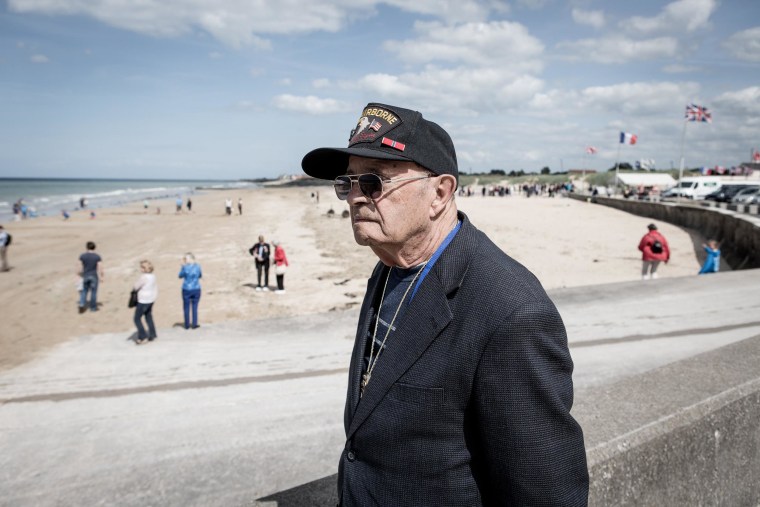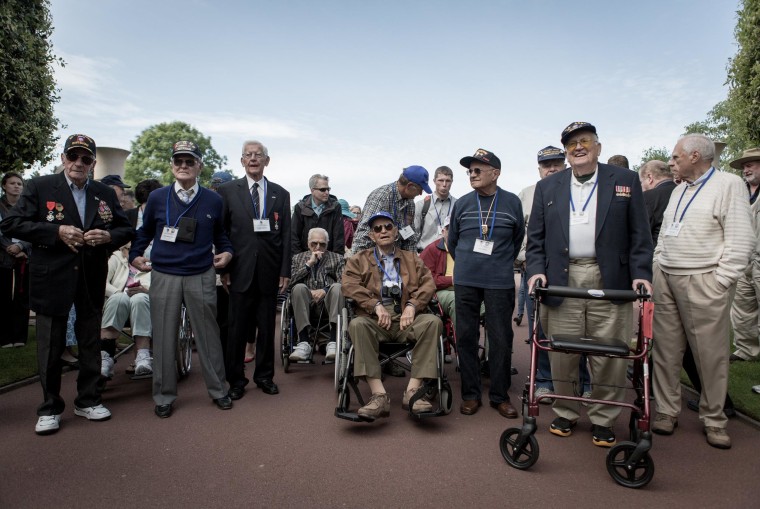John Cipolla still remembers the flash of fear he felt when he jumped out of a plane at 1:30 a.m. on June 6, 1944, over Normandy, France. The C47 he exited burst into flames seconds after he left it. The sky looked like the 4th of July. He kept watching other aircrafts tumbling to the ground below him, exploding as they landed.
“We didn’t know what our mission was going to be,” recalled Cipolla, who served with the 101st Airborne, the fabled outfit that got paid $50 extra per month to parachute from planes hundreds of feet from the ground. “We didn’t know if it was going to work. All I was thinking was ‘what if the beach mission fails?’ We’re caught over here 15 feet behind enemy lines.”
For several decades, Cipolla, now 93, has told his D-Day story to journalists, students and historians, and has made numerous pilgrimages back to the battlefields. This week, for the 70th anniversary of D-Day, he traveled to Normandy to share his experiences with students from College of the Ozarks, who were right around his age when he jumped from that ill-fated C47.
The college in Point Lookout, Missouri, has been sending a group of 16 students and eight veterans to the key sites of World War II—among other American wars—since 2009. This year, the group will travel to Normandy, Bastogne in Belgium, where the Battle of the Bulge took place, and the Grand Duchy of Luxembourg, where George Patton is buried.

Fred Mullinax, the founder of the program, had run student tours of historical war sites before, but realized there was “tremendous value added when you can actually have a participant there talking about their experience. [The students] get specific, vivid pieces of information,” rather than a pat rundown in a history book.
For students, winning one of these Patriotic Education Trips is a more competitive process than gaining admission to the college itself: only one out of 14 applicants, who have to write a detailed essay stating their case, are selected to go. Each veteran is assigned to one male student and one female student. Ahead of the European tour, the students go through an intensive, three-part orientation that involves reading books like The Longest Day by Cornelius Ryan, watching the Band of Brothers mini-series, and meeting veterans.
An emphasis on World War II made sense to Mullinax because of the dwindling number of living veterans, and because the narrative, on the European front at least, is “pretty cut and dry. If there was ever a case of good versus evil, it was this.”
Mullinax has also organized trips for veterans of battles with far less unity on the home front: the Korean War, the Cold War (for veterans who served in China shortly after WWII), and even an upcoming journey for men who served in Vietnam. But at College of the Ozarks, a Christian school that explicitly includes patriotism as one of its “visions and goals,” reverence for the military trumps any potential controversy. Many of the kids who attend are first-generation college students from small farming towns and military families. They come from places where “service to country is not a punchline,” Mullinax explained. “It’s something that people take very, very seriously.”

That’s certainly true for Jake Howdeshell, 19, who was assigned to Cipolla for this year’s trip. His family in Cherryville, Missouri (pop. 300), holds the military in high regard. Patriotism is a “big thing in my household”; his family throws 90-person reunion parties every July 4th. This trip, in particular, struck a nerve with Howdeshell: his great-grandfather flew over Normandy on D-Day and died in the Battle of the Bulge. Everyone in his family knows about the moment when a serviceman approached his great-grandmother shucking peas and informed her that her husband was dead. She started screaming, and Howdeshell’s grandfather, who was six at the time, hid under the stove.
Howdeshell sees this trip as an opportunity to hear the stories his great-grandfather never got to tell him.
“It’s the closest I’m ever going to get to meeting him, so I thought that would be really interesting to see the land he was fighting on,” he said. This week traveling to France was the first time Howdeshell boarded a plane.
"You can read about it all you want, but seeing real people who were there in real places—that’s different.”
Cipolla got a chance to chat with Howdeshell at a lunch preceding the last orientation, which took place a few weeks before D-Day. Cipolla, who’d flown in from Rochester, New York, was flanked by Howdeshell on one side and Whitney Garrison, a third-year nursing student, on the other. Both of them spent the meal absorbed by Cipolla’s anecdotes. Garrison, in particular, peppered the veteran with questions about what he remembered and how he felt. Her great-grandfather also fought in World War II, but he never talked about it.
“He wasn’t very open about it unless you asked pinpoint questions,” she said. “He had mementos on the wall, but especially when he first came back, [my parents said] he didn’t talk about it at all.”
Cipolla used to be like that, too. His parents didn’t ask questions when he returned from Europe, “maybe because they were afraid of learning about the darker moments,” he said. And there were many of those. Besides the more glamorous stories of D-Day and the Battle of the Bulge, Cipolla’s outfit liberated several concentration camps. He remembers the piles of bodies in the trenches, sprayed with bullets by fleeing Germans, and a few people folded among the corpses, still alive, moaning for help.

He also remembers his own close call: the time when artillery blew through his jaw, knocking him out. When two other soldiers hurled him onto a truck, assuming he was dead, the impact was so hard he grunted and came to. At that moment, the soldiers realized he was still alive and rushed him to a field hospital.
Still, the two previous times he’s been back to Normandy with College of the Ozarks haven’t triggered traumatic memories, Cipolla said. Instead, it’s brought back feelings of pride. He remembers wearing the “fancy jumpsuit” and a hat with a parachute insignia. The regular soldiers he spoke with in town resented him, asking, “How come you guys get all that money?” He responded, “How would you like to jump out of an airplane?”
When he speaks to students, he usually tries to shy away from the atrocities, instead telling unique, light-hearted stories that give color to History Channel mainstays. A tale he told Garrison and Howdeshell over lunch—one of his favorites—is about liberating a small town in Holland one “pitch-black, spooky” night. The Germans fired a cannon down the middle of the narrow road, so Cipolla smashed a window of a house and dove inside to take cover.
Suddenly, an elderly woman with curlers started screaming and hitting him with a cast-iron frying pan. Cipolla quickly “got the hell out of there” and warned his fellow soldiers: “Don’t go in that house—you’d be safer fighting the Germans than that crazy old lady.”
Cipolla asked his young charges questions, too.
“He asked me, ‘Are you nervous?’” Garrison said. “And I realized I was. I have no idea what kind of emotions are going to come from this trip. You can read about it all you want, but seeing real people who were there in real places—that’s different.”

Herbert “Andy” Anderson, 90, another D-Day veteran who’d driven in for the orientation from Bella Vista, Arkansas, admits there’s a sense of comfort in knowing that these students will pass on their knowledge. “It’s almost selfish,” he said. “I think we are trying to prolong our world in their minds.”
Anderson and his wife, Bonnie, have taken this trip once before, and have formed deep bonds with the students they got to know. Several students still visit them years later. Mullinax said that’s common; he said at least five veterans were present for the college’s graduation in early May because they’d kept in touch with the students.
Like Cipolla, Anderson had a slow-burn experience when he returned home after fighting in the 15th Special Brigade at Normandy. He simply didn’t discuss the war until 20 years ago, when local residents in Bella Vista were recording veterans’ experiences for the Library of Congress for the 50th anniversary of D-Day. He’d kept lots of mementos from the war (medals, a hat, letters to Bonnie) and he finally brought himself to look through them. He started to remember details about the time he was almost killed in Belgium during the Battle of the Bulge—not in combat, but in a collision with 30-ton tank on the road. He remembered the seemingly impossible task of setting up a defensive perimeter on the beach at Normandy.

Nowadays, doing these tours, as well as working on getting a stolen emblem at Omaha Beach restored, is “my lifeblood. It’s given me something to worry about and think about. It keeps me going.”
This D-Day, the group will be visiting that same emblem on Omaha Beach, as well as other tour stops tailor-made for these veterans. Cipolla recalls one of the best moments on his last trip was seeing his tree at the Peace Woods in Bastogne, where each veteran who returns to that spot can choose a tree with a plaque bearing his name. During that trip, a student at the College of the Ozarks suggested they create the same thing on campus. Veterans Grove was established near the entrance of the college’s Keeter Center shortly afterwards, and the grove is now dotted with more than 50 sugar maples honoring the veterans who have traveled on past trips.
“Mine was the first tree they planted,” Cipolla said. “It’s a good idea, because it’s this very permanent thing.”
Education coverage for NBCNews.com is supported by a grant from the Bill & Melinda Gates Foundation. NBC News retains sole editorial control over the content of this coverage.